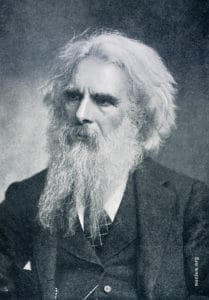Eadweard Muybridge (1830-1904, originally Edward James Muggeridge) is one of the most important pioneers in photography and photo technology. Muybridge was born in Kingston upon Thames near London and grew up in rather simple circumstances. He emigrated to the United States in the early 1850s and initially lived in New York City, and since 1855 in San Francisco. From 1856 on he worked here as a successful bookseller for the “London Printing and Publishing Company”. Now he is also starting to change the spelling of his last name several times. On the way to Europe, Muybridge suffers a serious head injury in a stage coach accident, which he gets treated in England from 1861 on.
It is probably in England that Muybridge deals more intensively with the young technique of photography. After returning to San Francisco in 1867, he is able to start his own business as a photographer. His first major photo expedition takes him to the Yosemite Valley, just over 200 kilometers away, in the same year.
Muybridge was innovative early on and starts to develop new techniques and methods, for example to be able to react to specific lighting conditions. Already in 1868 he receives his first government contract to document photographically the Department of Alaska, which had been acquired by the Russian Empire in 1867.
In 1875 by the way, Muybridge managed to be acquitted for the willful murder of his wife’s lover.
After first attempts in 1872 to photograph the motion sequences of a racehorse, Muybridge develops the method of chronophotography in the late 1870s – i.e. the documentation of movement phases by burst mode, using a variety of cameras and a special, electromagnetically controlled shutter technology. For this he is most famous until today. Muybridge publishes the first chronophotographical documentation of a horse’s movement in 1878 as a series of positive prints (“The Horse in Motion”).
The new technology is received euphorically, and already in 1879, Muybridge presents his Zoopraxiscope for the first time – a fitting projection device for his chronophotographic image series and an important predecessor of the movie projector. In 1894 he returns to his birthplace, where he dies of cancer in 1904.
Publications
Muybridge’s most important publications include, on the one hand, his numerous photo series, for example approx. 400 photos, which are the result of a major trip to Central America and are published in 1875 as “The Pacific Coast of Central America and Mexico, Isthmus of Panama, Guatemala, and the Cultivation and Shipment of Coffee”.
Most important, however, are his chronophotographic documentations, whose iconographic images seem to be better known today than ever before. They were originally published in the voluminous work “Animal Locomotion: An Electro-Photographic Investigation of Consecutive Phases of Animal Movements” (1887) with a total of 781 plates. Further publications are based on its material and present selections of the image series first published in 1887: “Animals in Motion, an Electro-Photographic Investigation of Consecutive Phases of Animal Progressive Movements” (1899) and “The Human Figure in Motion, an Electro-Photographic Investigation of Consecutive Phases of Muscular Action” (1901).
Muybridge also describes his working methods in the not very extensive publication “Descriptive Zoopraxography or the science of animal locomotion” (1893).


